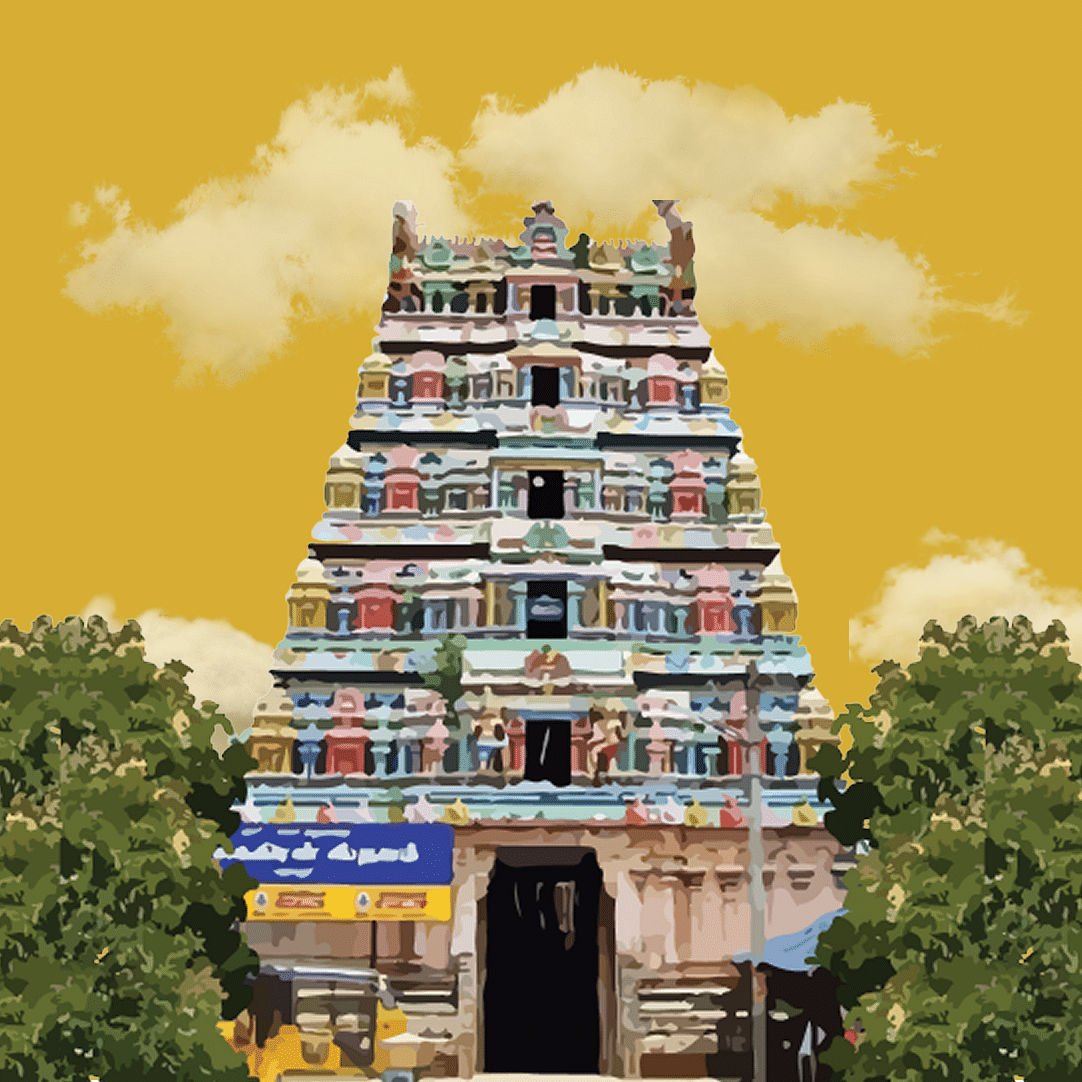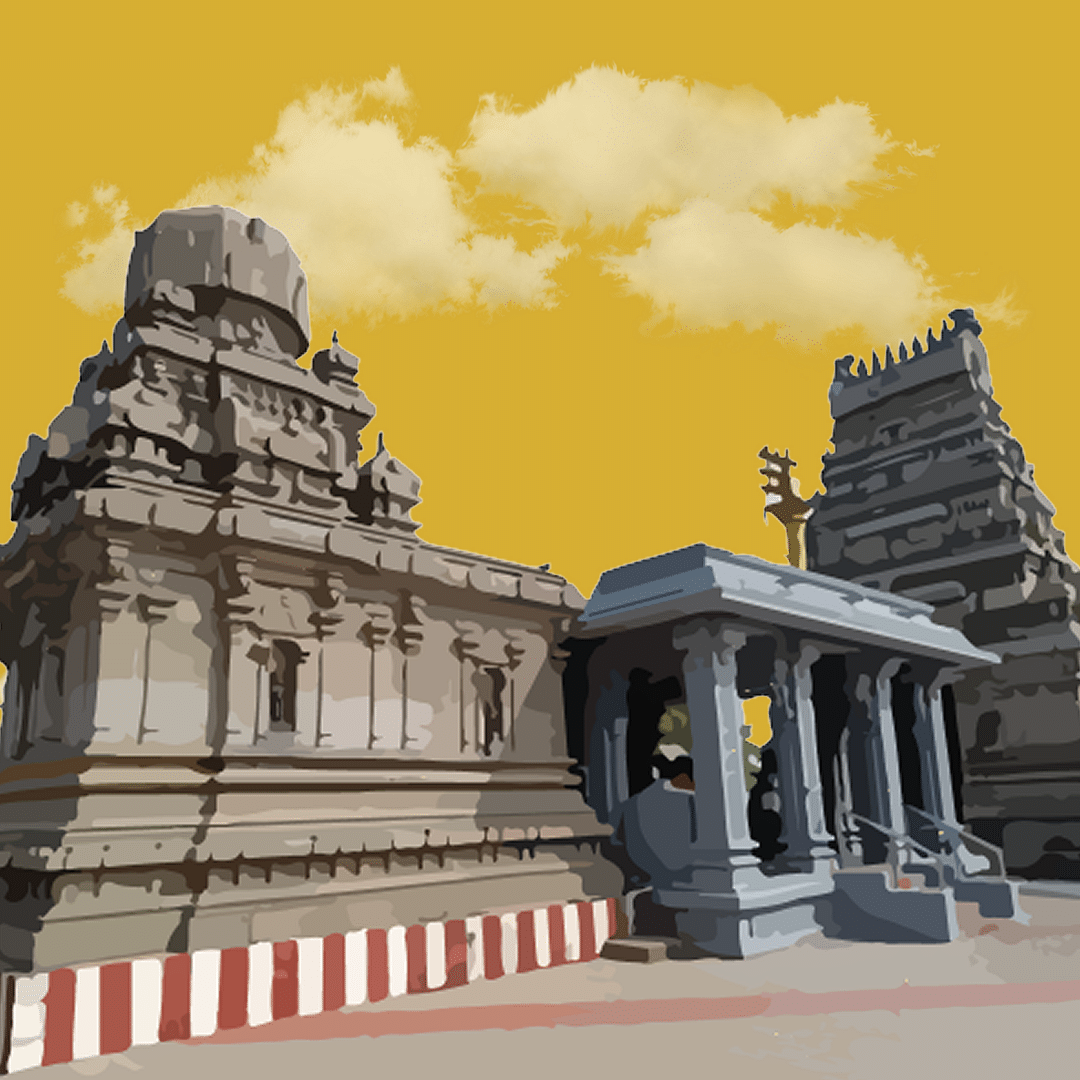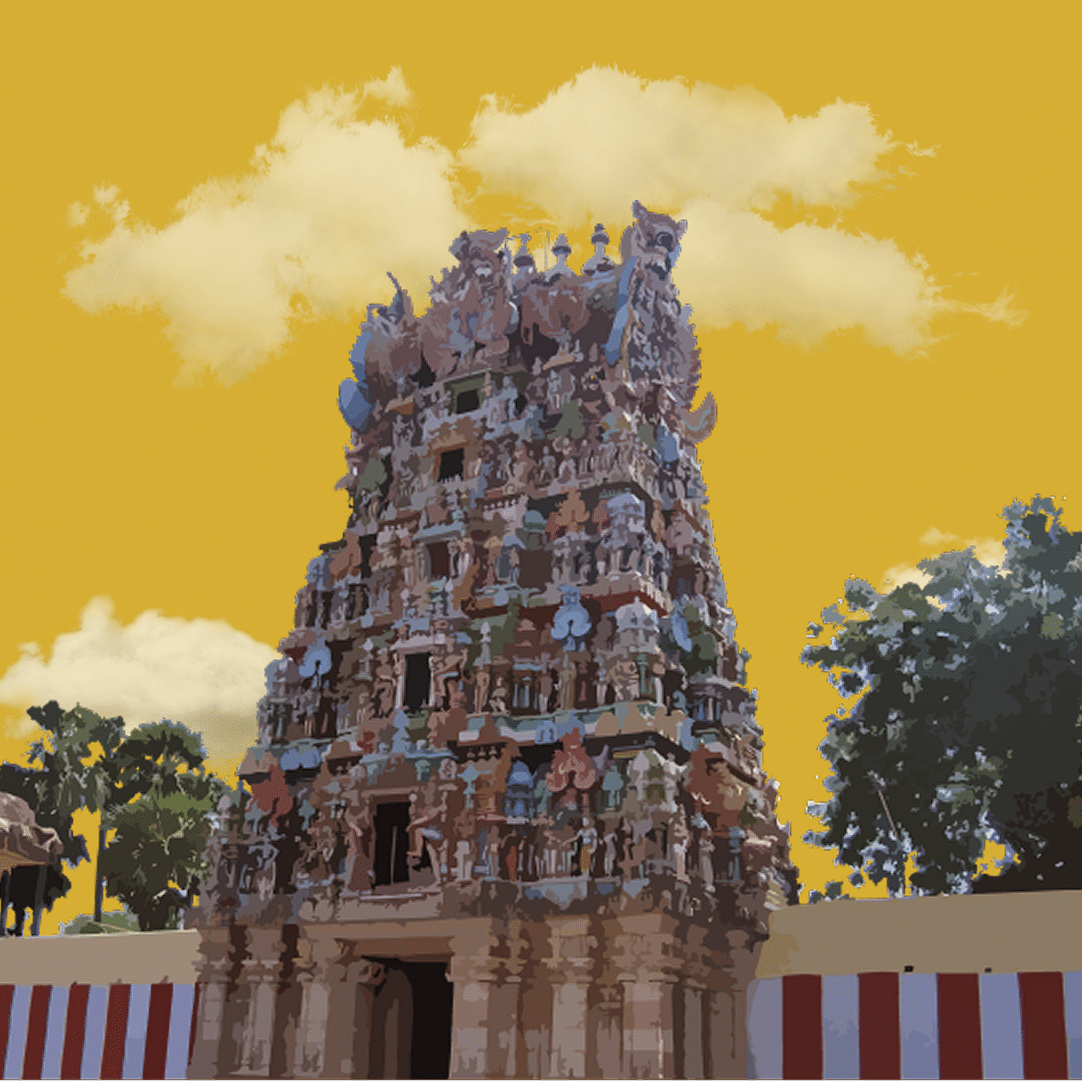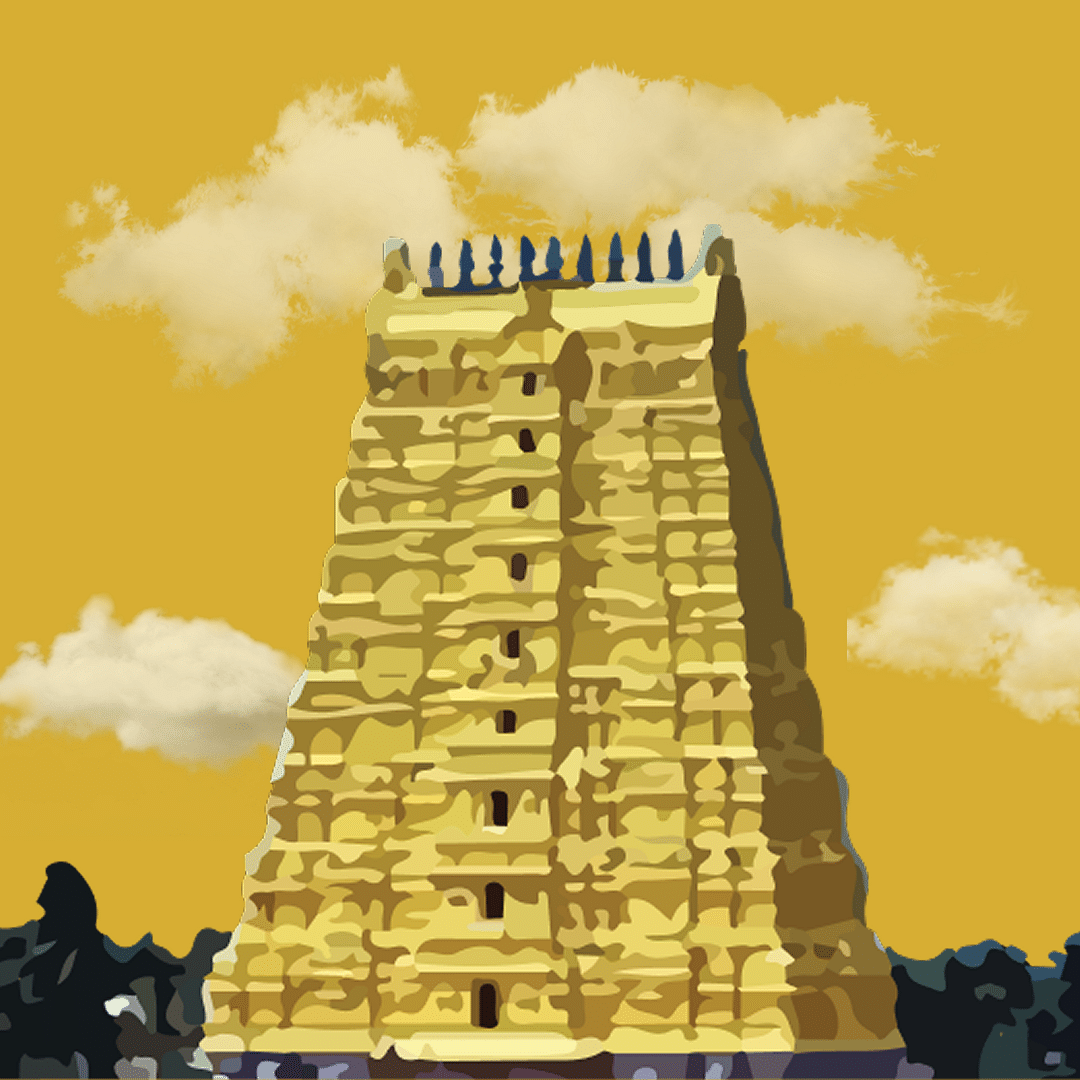Home > The GReaT Divine Darshan > Tiruttani
HOLY PLACES
IN TIRUTTANI
Tiruttani isn’t loud about its charm—it’s the kind of place that quietly tugs at your heartstrings. Nestled in the arms of rolling hills and sacred silence, this divine town invites you to slow down, breathe deeper, and listen a little closer. The temples in Tiruttani, especially the famed hilltop Murugan temple, aren’t just places of worship—they’re soul spaces. The climb upwards isn’t merely about steps—it’s about shedding the rush and rising into clarity. Down below, life hums gently through age-old streets, where local flavours and stories linger longer than expected. And as twilight paints the sky with temple silhouettes, you’ll realise Tiruttani doesn’t just offer darshan—it gives you a rare kind of peace that stays long after the journey ends.
_be06b6dc)
 OUR Hotels
OUR Hotels
IN THE CITY, BY THE SACRED SITES 🏙
)
Regency Tiruttani by GRT Hotels
Looking to elevate your spiritual getaway? Regency Tiruttani by GRT Hotels is your divine stopover in the holy city of Tiruttani—just a stone’s throw away from the revered Subramaniya Swamy Temple. Much like the temple’s 365 steps, our doors are open all year round, ensuring your pilgrimage is wrapped in comfort and care. With 45 thoughtfully designed rooms that feel nothing short of sanctuaries, you can rest easy and rise refreshed. Feeling peckish after your prayers? Our in-house restaurant caters to both vegetarian and non-vegetarian palates, with every meal prepared with love and respect for your preferences. Planning a celebration? Our elegant event spaces are perfect for sacred unions and special occasions alike. Come seeking blessings or simply to soak in the serenity—either way, you’ll find your stay radiantly GReaT.
 OURDivine Destinations
OURDivine Destinations
TRAVEL THROUGH THE MUSEUMS OF FAITH 🛕
_6ffbd646)
ARULMIGU SUBRAMANIYA SWAMY
TEMPLE ✨
Perched atop a hill with 365 steps symbolising every day of the year, this sacred abode of Lord Murugan in Tiruttani radiates divine calm and ancient power.
Distance from Regency Tiruttani4 km
Timing5:45 a.m. to 9:00 p.m.
FestivalBrahmotsavam: A grand festival with Valli Kalyanam on the 8th day (Feb)
Thaipusam: (Jan)
Aadi Krittikai: (Jul/Aug)
Skanda Sashti: Celebrated in the Tamil month of Aippas (Oct-Nov)Sacred Food OfferedTamarind rice & Laddu
Transportation CostFor assistance, please contact the front desk.
Disclaimer: The temple's timings are subject to change as per the operating committee's decisions.
About Arulmigu Subramaniya Swamy Temple:
- The temple is a revered destination for devotees seeking spiritual solace, healing, and emotional calm.
- The temple is one of the six sacred abodes of Lord Murugan (Arupadai Veedu).
- It is situated atop a hill and is accessed by 365 steps, symbolising each day of the year.
- Unlike other Murugan temples, Soorasamharam is not celebrated here, as this sacred site marks the place where Lord Murugan’s anger was pacified after the battle with the demon Sooran.
- It is the only Arupadai Veedu within the Chennai Metropolitan Area, just about 87 km from the city.
Divine Facts:
After the thunderous battle at Thiruchendur, where Lord Muruga vanquished the formidable asura Surapadman, one might expect celebrations in the celestial realms. But Muruga, the divine warrior, sought no victory parade. He ascended a quiet hill in search of stillness. That hill was Thirutani. Here, the air was gentler, the skies calmer, and the only sound was that of silence, soft, soothing, and sacred. Muruga rested, laying down his Vel, his divine spear, and allowed peace to bloom within him. The hill, touched by his tranquillity, came to be known as Shantipuri—the abode of peace. But Thirutani held more than calm winds and sacred silence. It became the stage for divine love. Muruga, ever the charming strategist, wooed and won Valli, a tribal princess with a fiery spirit. Their union, celebrated with simplicity and joy, found its sacred ground here. If Deivanai symbolised royal alliance, Valli was the heartbeat of the earth—and it was at Thirutani that their love took form. Over time, the hill drew not just lovers and warriors, but seekers. Many of them. Lord Rama came here after defeating Ravana, seeking peace of mind. Arjuna, the Pandava prince, stopped during his southern pilgrimage to offer his prayers. Lord Vishnu, whose divine discus and conch were snatched away by the asura Tarakasura, prayed here and reclaimed them. Sage Agastya, the revered rishi, received the gift of the Tamil language from Muruga on this very hill. Even Vasuki, the serpent used during the churning of the Milky Ocean, found healing here—his wounds soothed by the grace of Muruga. And what a temple stands atop this hill. While most Murugan temples place a proud peacock beside the Lord, here, it is Airavata, the white elephant of Indra, who stands before the sanctum. A celestial in-law gift, perhaps. Muruga himself appears different too, not as the armed commander but as the peaceful divine. His Vel and Seval Kodi (rooster flag) lie nearby, resting, as if even they too needed a break from all that cosmic drama. Then there’s the sandalwood stone—another gift from Lord Indra, offered during Muruga’s wedding to Deivanai. From this sacred stone, priests prepare sandal paste. But unlike other temples, this isn’t for smearing on the forehead. Instead, it is mixed with water and consumed. It is believed to hold healing properties, capable of soothing both body and spirit—a divine medicine, served with a spoonful of faith. The journey up to this holy shrine isn’t just measured in distance, but in days. 365 steps lead the way to the sanctum, each representing a day of the year. Climbing them feels like walking through time itself—one step for each worry shed, each prayer whispered. And then, there was Muthuswami Dikshitar. A man of music, yet adrift in silence—until he arrived at Thirutani. Legend says Lord Muruga appeared before him in the form of an old man, offering him prasadam. That morsel wasn’t just food—it was a spark. Dikshitar’s heart opened, melodies poured forth, and from silence came symphony. That day, a composer was born.MATHUR TEMPLE ✨
Believed to be a powerful Shakti Sthalam, this temple near Tiruttani is dedicated to the fierce and protective Mahishasura Mardhini Amman—where miracles are whispered and devotion roars louder than doubt.
Distance from Regency Tiruttani12 km
Timing7:00 a.m. to 8:00 p.m.
FestivalNew moon and Full moon: Milk Abishekham with 108 litres of milk, and special homams are conducted on a very grand scale
Annual Fire walking festival: (Mar)Transportation CostFor assistance, please contact the front desk.
Disclaimer: The temple's timings are subject to change as per the operating committee's decisions.
About Mathur Temple:
- The temple is situated in Mathur village, near Tiruttani, in the Thiruvallur district of Tamil Nadu.
- It is dedicated to Goddess Sakthi, worshipped here in her powerful form as Mahishasura Mardhini.
- The temple shares an ancient and sacred connection with the Tiruttani Murugan Temple, as told in local legends.
- It is widely known for its miraculous events and the strong spiritual energy that surrounds it.
- Devotees regard the goddess both as a loving, nurturing mother and a fierce protector, depending on their needs and prayers.
- The temple is frequently visited by those seeking divine assistance, especially during times of personal or emotional struggle.
- On new moon and full moon days, a milk abhishekam using 108 litres of milk is performed, along with special homams conducted in an elaborate and reverent manner.
Divine Facts:
Once upon a time, when the forces of darkness threatened the balance of the world, the divine mother took the fierce form of Mahishasura Mardhini to vanquish the mighty demon Mahishasura. After the battle, legend says that she chose Mathur, near Tiruttani, as her sacred resting place. Here, she radiates both serenity and power—guiding devotees with love, and guarding them with the wrath of a warrior goddess. The temple’s connection with Lord Murugan’s abode at Tiruttani adds to its spiritual gravitas, as it’s believed the divine energies of both deities protect the region in harmony._32fda2f6)
_f43a798e)
VADARANYESWARAR SWAMY TEMPLE, THIRUVALA ✨
Built in the 12th century by the Cholas, Sri Vadaranyeswarar Temple in Thiruvalangadu is where Lord Shiva is believed to have performed his cosmic dance—an eternal symbol of devotion and divine energy.
Distance from Regency Tiruttani23 km
Timing6:00 a.m. to 7:30 p.m.
FestivalThiruvadhirai: It is celebrated in the Tamil month of Margazhi (Dec-Jan)
Shivaratri: (Feb-Mar)Transportation CostFor assistance, please contact the front desk.
Disclaimer: The temple's timings are subject to change as per the operating committee's decisions.
About Sri Vadaranyeswarar Temple Thiruvalangadu:
- Built during the 12th century by the Chola dynasty with inscriptions dating back to the 5th century CE.
- One of the 275 Paadal Petra Sthalams and the 15th Shiva Sthalam in Thondai Nadu.
- The temple is home to a self-manifested (Swayambhu) Lingam and is also known as Rathina Sabhai (Gem Hall).
- One of the five sacred places where Lord Natarajar performed his cosmic dance.
- It is worshipped by Saint Karaikkal Ammaiyar, Thiru Gnanasambanthar, and several celestial beings.
- The Natarajar shrine within the temple houses two rare Lingams—one crafted from Spadigam (crystal) and the other from Maragatham (emerald).
- A special place of worship for those born under Bharani Nakshatra and for relief from Shani Dosham.
- The temple’s 100-pillared hall and the lotus-shaped temple chariot reflect Chola and Pallava architectural grandeur.
Divine Facts:
Nestled amidst a forest once abundant with banyan trees, Sri Vadaranyeswarar Temple is a sanctuary of cosmic energy and spiritual depth. Legend tells of a divine dance duel between Lord Shiva and Goddess Kali, initiated to quell her uncontrollable fury after vanquishing the demons Sumban and Nisumban. Witnessed by celestial beings and sages, the dance ended with Shiva's mesmerising ‘Oordhuva Thandavam’—a move so graceful and divine that Kali accepted defeat, restoring peace across the realms. It is also where the revered Karaikkal Ammaiyar, a great devotee, walked on her head to witness Shiva’s celestial dance and found her eternal resting place at his feet. With every step and shrine steeped in sacred lore, this temple continues to echo with the rhythm of devotion and timeless legends.ARULMIGU SRI YOGA NARASIMHA SWAMY TEMPLE ✨
Set atop 1,305 steps, the hilltop shrine of Sri Yoga Narasimhar in Sholingur marks the divine spot where Lord Vishnu revealed his fierce form to the Saptha Rishis—one of Tamil Nadu’s most sacred hill Divya Desams.
Distance from Regency Tiruttani33 km
Timing8:00 a.m. to 5:30 p.m.
FestivalChittirai Brahmotsavam: (Apr/May)
Avani Pavitrotsavam: (Aug/Sep)
Karthigai Thiruvizha: (Nov/Dec)
Narasimha Jayanthi: (May/Jun)Sacred Food OfferedSweet pongal, Puliogare, Curd rice, Thattai, Laddus and Vada malai.
Transportation CostFor assistance, please contact the front desk.
Disclaimer: The temple's timings are subject to change as per the operating committee's decisions.
About Sri Yoga Narasimhar Temple Sholingur:
- Located in Vellore district, Tamil Nadu, this temple sits atop a 750-foot hill with 1,305 steps.
- It is considered one of the most sacred hill Divya Desams in Tamil Nadu.
- Lord Narasimha is believed to have reappeared here to bless the Saptha Rishis.
- The temple is known to relieve devotees of ailments and negative energies.
- Spending just 24 minutes (one kadigai) here is believed to grant moksha (liberation).
- The temple also houses the shrine of Sri Yoga Anjaneyar on a nearby hill with 406 steps.
- Swamy Doddacharya, a revered Vaishnavite saint and scholar from around 470 years ago, was a devoted acharya who played a vital role in reviving and preserving the traditions of this temple; his lineage continues to oversee the rituals and festivals even today.
- Bhaktavatsala Perumal Temple, located downhill, is also part of the Thirukkadigai Divya Desam.
- A rare occurrence of rainfall is said to follow special abhishekams performed at the temple.
Divine Facts:
Long ago, the fierce yet benevolent Lord Narasimha—who once appeared at Ahobilam—manifested again atop the Sholingur hill, answering the intense penance of the Saptha Rishis. These sages sought a glimpse of his divine form within the span of a kadigai, or 24 minutes. Moved by their devotion, the Lord appeared in a meditative yogic posture, radiating tranquillity and power. This sacred moment earned the hill the name ‘Thirukkadigai’ and established the belief that even a short stay here can grant liberation. The echo of that divine darshan still lingers in the air, drawing seekers from far and wide in hope and faith._0ca26e50)




